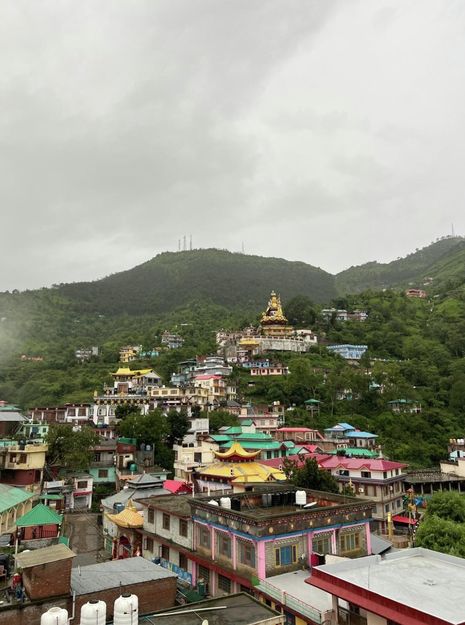Experience: what studying with Tibetan refugees taught me about Tibetan identity
Sarah College is a blend of college and monastery. NBA vests and monastic robes alike rub shoulders on the basketball court

I’m Norpell Wilberforce. Funky name, eh? The first name is Tibetan, like my mother, and the surname is English, like my father. I’m sure that many of you reading this are yourselves mixed heritage and have experienced how this uniquely affects your identity. If you've lived in both cultures, you’ll know how this shapes your feeling of where you belong and who you are.
My grandparents are Tibetan refugees living in a refugee settlement in South India. My family and I lived there when I was a young child. I went to a school taught entirely in Tibetan. I ate Tibetan food. I became semi-fluent in Tibetan. My uncles were monks - I often accompanied them to the local Tibetan Buddhist monastery. I was immersed in Tibetan language, culture, and religion - they formed the core of my Tibetan identity.
However, this summer I’ve questioned what this means. I’ve just finished a month-long course at Sarah College, founded by His Holiness the 14th Dalai Lama in 1991 to give Tibetan refugees an education equipping them with life skills they need to enter and function within society.

Sarah College was unlike any educational project I’d experienced. It’s a blend of college and monastery, students and monks living and studying together. This unique blend is felt at every corner. NBA vests and monastic robes alike rub shoulders on the basketball court. Depending on when you walked past, you could either hear the monks’ chanting from the prayer hall or the sounds of Tibetan hiphop from somebody’s room. There’s a real sense of cultural synthesis, and many of the monks are non-Tibetans who have learned to speak Tibetan – I approached one white monk, asking him a question in English, and received an answer in perfect Tibetan with an Australian accent.
I started each day with prayers and meditation, followed by Tibetan language class wherein I would study grammar and translation. Before lunch was “Tibetan culture” class and after we’d have conversation class, chatting together for an hour and a half. These conversations became very personal, and I was deeply inspired by their stories and resilience. Many had fled to India and, due to the media blackout in Tibet, have not heard from their families in years. One student I met was separated from their family on their journey from Tibet and still does not know if they made it. Yet they still speak of Tibet with a nostalgia that is simultaneously melancholic, hopeful, and indomitable. Their spirits have not been crushed. The intensity of their feelings of “Tibetan-ness” made me reflect on mine.
Through these conversations, I began to understand the elusiveness of Tibetan national identity.

National identity, as distinct from regional, cultural, linguistic, or other dimensions of identity, emerges from a people’s acceptance and claiming of the same construct of the nation and state. However, Tibetan identity has historically been rooted in these other dimensions rather than national identity in the previous sense.
Since the fall of the Tibetan Empire in the ninth century, there hasn’t been a coherent sense of Tibetan national identity. Given the impossibility of integrating the extreme terrain of Tibet under a unified body politic, governments only exercised power within Central Tibet. Tibetans elsewhere rejected their authority, following regional leaders. The religious and linguistic identities of Tibetan Buddhism and language, rather than an identification with a construct of the nation and the state, were the cornerstones of Tibetan identity. And so, in 1911, when the government of the 13th Dalai Lama declared itself ruler of Tibet, the region wherein it could exercise its rule excluded over half of ethnic Tibetans. Tibetans in other regions accepted his spiritual authority as the figurehead of Tibetan Buddhism but rejected his government’s political authority and construct of national identity. Tibetan identity was felt through language and religion rather than national identity, right until the CCP’s invasion in 1949.
Now the Tibetan refugee diaspora is global, and we’re faced with having to create a national identity encompassing all ethnic Tibetans. This is complexified by the secularisation of Tibetan government, with the Dalai Lama seceding all political authority to the elected government in exile in 2011. The traditional icon uniting all Tibetans has been replaced with an exiled government, crippled by regional sectarianism.
Under Chinese occupation, our cultural, religious, and linguistic identities are persecuted. Our nomadic life is being exterminated and hundreds of thousands of nomads are being forcibly resettled into urban compounds – many of which are the families of the refugees on my course. Many of the monks I met at Sarah College fled to India after their monasteries were destroyed. In 2019, the CCP ordered all schools to teach in Chinese, making teaching Tibetan imprisonable. Students risk being beaten by Chinese teachers and other students if they speak their language in the classroom.
Despite this, Tibetan identity still burns bright. I am an example of it. So is my mother and I speaking Tibetan together; my grandparents praying to a portrait of His Holiness that they can one day return to Tibet; celebrating Tibetan New Year at Cambridge with friends; my girlfriend learning Tibetan; the refugees I met who, despite their immense suffering and exile, remain connected to their original culture; whether you realise this or not, you, by reading this article are an example of it.
Given the fragmentation of our national identity, Tibetan identity is maintained not by the collective workings of a nation but through the isolated acts of individuals and communities. I’ve learnt that I am a Tibetan through the things I do, not my race or any national construct, the foreign monks showed me that you don’t need to be a Tibetan to feel Tibetan.
I believe the most beautiful thing about Tibetan-ness is its adaptability. Although we’ve been exiled, we forge a piece of Tibet wherever we go. As my grandparents and the refugees I met brought a piece of Tibet to India, it’s for me to bring a piece to England. It is inevitable that I absorb non-Tibetan cultural influences too, but I welcome this. If, through this, I can make Tibetan identity more accessible and more relatable, I am keeping Tibet alive. I, and Tibet, ask you to help me.
 Interviews / You don’t need to peak at Cambridge, says Robin Harding31 December 2025
Interviews / You don’t need to peak at Cambridge, says Robin Harding31 December 2025 Comment / What happened to men at Cambridge?31 December 2025
Comment / What happened to men at Cambridge?31 December 2025 News / Unions protest handling of redundancies at Epidemiology Unit30 December 2025
News / Unions protest handling of redundancies at Epidemiology Unit30 December 2025 News / Varsity’s biggest stories of 202531 December 2025
News / Varsity’s biggest stories of 202531 December 2025 News / Downing investigates ‘mysterious’ underground burial vault 29 December 2025
News / Downing investigates ‘mysterious’ underground burial vault 29 December 2025










